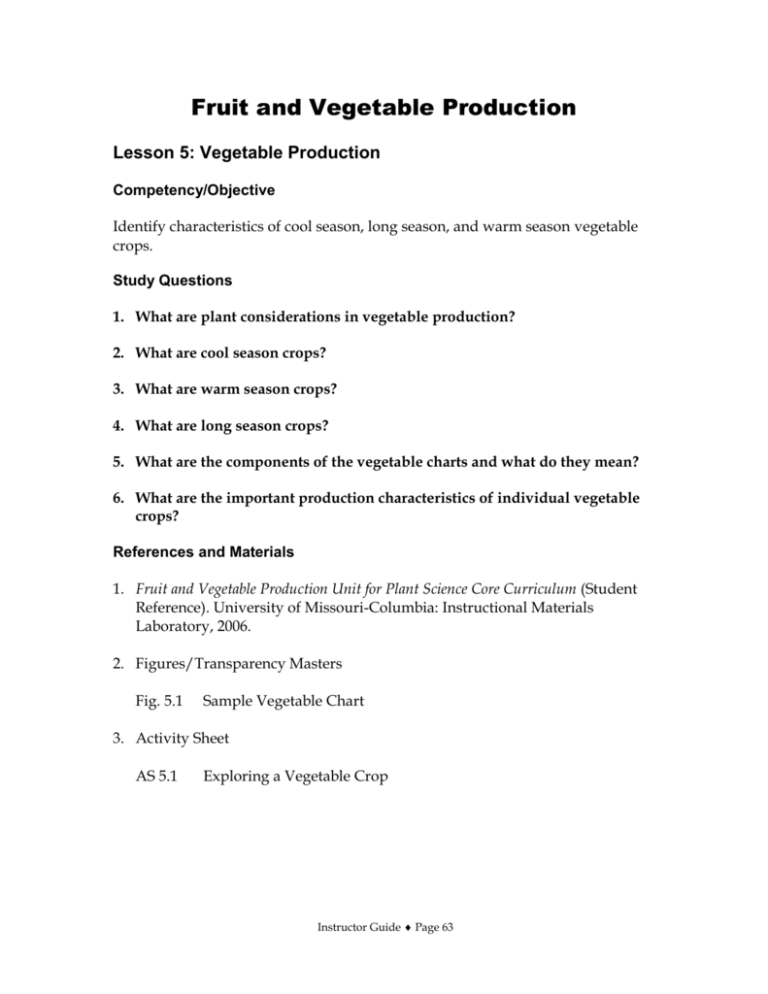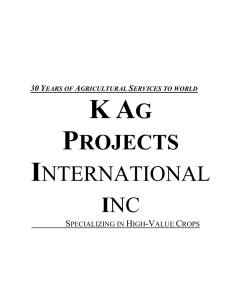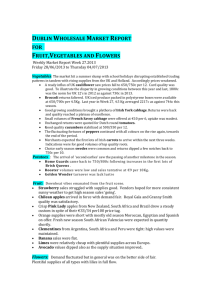Course: Animal Science - Missouri Center for Career Education
advertisement

Fruit and Vegetable Production Lesson 5: Vegetable Production Competency/Objective Identify characteristics of cool season, long season, and warm season vegetable crops. Study Questions 1. What are plant considerations in vegetable production? 2. What are cool season crops? 3. What are warm season crops? 4. What are long season crops? 5. What are the components of the vegetable charts and what do they mean? 6. What are the important production characteristics of individual vegetable crops? References and Materials 1. Fruit and Vegetable Production Unit for Plant Science Core Curriculum (Student Reference). University of Missouri-Columbia: Instructional Materials Laboratory, 2006. 2. Figures/Transparency Masters Fig. 5.1 Sample Vegetable Chart 3. Activity Sheet AS 5.1 Exploring a Vegetable Crop Instructor Guide Page 63 Fruit and Vegetable Production Teaching Procedures A. Review Lesson four discussed the basic methods of pest management and the general steps and benefits of an integrated pest management strategy. This lesson covers cool, warm, and long season crops and important aspects of vegetable production. B. Motivation Ask students to picture a grocery store produce aisle. What do they see? How are the various crops produced? How do the plants grow? C. Assignment D. Supervised Study Lead students in collecting the information needed to answer and discuss the study questions. The instructor may choose to work on one study question at a time or have students consider all the study questions before the discussion. Another option is to have students work in a cooperative learning environment by forming groups and assigning different study questions to each group. E. Discussion Lead students in a discussion of the study questions. Supplement students’ responses and information with additional materials when needed. 1. What are plant considerations in vegetable production? Ask students what they know about vegetable production. What are some things that need to be considered? Why are these things important? a. The term vegetable is generally used to refer to the edible portion of herbaceous (nonwoody) plants—the roots, stems, leaves, flowers, or fruit. b. Different varieties and hybrids of vegetables offer certain desirable characteristics, such as good size, flavor, and appearance and resistance to certain pests and diseases. Instructor Guide Page 64 Fruit and Vegetable Production i. Variety: plant that occurs naturally or through cultivation and differs from other members of its species by one or more characteristics ii. Hybrid: plant that results from interbreeding two distinct cultivars, varieties, or species 2. What are cool season crops? Ask students to explain what cool season crops are. Why is it important to know about cool season crops? a. A cool season crop is a crop that grows best during the cool temperatures of fall and spring. i. Cool season crops prefer temperature between 50°F and 70°F. ii. They are very tolerant of cold weather and can usually stand a light frost. iii. Examples: beets, carrots, potatoes, cabbage, and cauliflower iv. Two primary types of cool season crops are root crops and surface crops. 1. Root crops: vegetables that are primarily cultivated for their edible roots, tubers, or modified stems, which grow below ground 2. Surface crops: vegetables that are grown for edible parts—leaves, flowers, and “fruits”—that grow above ground 3. What are warm season crops? Ask students what vegetables are considered warm season crops. Why are these crops considered warm season crops? a. Warm season crops are crops that are severely harmed by frost and do not grow well until the temperature is at or above 70°F. i. Warm season crops should only be planted when soil temperature is warm enough to induce sprouting. ii. Examples: tomatoes, eggplants, and corn 4. What are long season crops? Ask students what vegetables are considered long season crops. Why are these crops considered long season crops? a. Long season crops are vegetables that require a relatively long growing season to mature compared to other plants. i. Examples: pumpkins, gourds, and watermelons Instructor Guide Page 65 Fruit and Vegetable Production 5. What are the components of the vegetable charts and what do they mean? Ask students what they would need to know about a specific crop if they were going to grow it. How could knowing this information help them with production? Refer to Figure 5.1 Sample Vegetable Chart. a. Different types of vegetables will be discussed in this lesson using a chart format. Vegetable chart components are discussed below. i. Days to Germination: The days to germination is an estimated number of days before a plant will begin to grow and sprout. ii. Days to Maturity: The days to maturity is the estimated number of days from planting until a usable or salable product can be harvested. iii. Soil: This section of the chart explains what soil conditions are desirable for the plant to grow, such as the recommended soil pH, texture, and drainage. iv. Spacing: Spacing requirements provide a guideline for how much space to leave between plants and rows to allow adequate room for growth, cultivation, and harvesting. v. Harvest: The harvest section provides general guidelines to help determine when the crop is ready to be harvested and how to harvest the crop. vi. Postharvest: Proper storage and handling procedures are listed in the postharvest portion of the chart. vii. Production Concerns: Crop-specific information to facilitate proper growth and production is supplied in the production concerns section. viii.Pests and Diseases: This section lists common pests and diseases that affect the specific crop. ix. Other Considerations: This heading provides a place to include cropspecific concerns that are not associated with other areas of the chart. 6. What are the important production characteristics of individual vegetable crops? Ask students what vegetable crops grow in the area. What types of vegetable crops have students grown? a. The instructor should choose vegetable charts to discuss in class from those provided or use blank charts to develop charts for other crops as needed. b. The instructor should distribute blank charts to students to fill out during class discussion or as part of their assigned work. c. Charts for the following vegetables are included with this unit. A blank chart for student charts and other vegetables is included with each group. Instructor Guide Page 66 Fruit and Vegetable Production i. Cool season root crops 1. Beets 2. Carrots 3. Potatoes 4. Radishes 5. Turnips 6. Others ii. Cool season surface crops 1. Asparagus 2. Cabbage 3. Cauliflower 4. Lettuce 5. Spinach 6. Others iii. Warm season crops 1. Cucumbers 2. Eggplants 3. Green beans 4. Okra 5. Peppers 6. Summer squash 7. Sweet corn 8. Tomatoes 9. Others iv. Long season crops 1. Cantaloupes 2. Gourds 3. Pumpkins 4. Watermelons 5. Winter squash 6. Others F. Other Activities 1. Have students plant 10 vegetable seeds each and monitor them. Have students record the days the seeds germinate and the germination rate. 2. Start a production site where students can watch and identify the different types of vegetables as they mature. 3. Have samples of each of the different crops studied in class for the students to see and taste. Instructor Guide Page 67 Fruit and Vegetable Production G. Conclusion Vegetables are the edible portions of herbaceous plants. They can be divided into three general categories based on their growing season: cool season, warm season, and long season crops. The charts that accompany this lesson summarize a number of key elements needed to produce a successful vegetable crop. Recommendations will vary depending on specific crops and growing conditions. H. Answers to Activity Sheet AS 5.1 Exploring a Vegetable Crop Answers will vary. I. Answers to Assessment 1. Students should provide the following answers. A. Days to Germination: The days to germination is an estimated number of days before a plant will begin to grow and sprout. B. Days to Maturity: The days to maturity is the estimated number of days from planting until a usable or salable product can be harvested. C. Soil: This section of the chart explains what soil conditions are desirable for the plant to grow, such as the recommended soil pH, texture, and drainage. D. Spacing: Spacing requirements provide a guideline for how much space to leave between plants and rows to allow adequate room for growth, cultivation, and harvesting. E. Harvest: The harvest section provides general guidelines to help determine when the crop is ready to be harvested and how to harvest the crop. F. Postharvest: Proper storage and handling procedures are listed in the postharvest portion of the chart. G. Production Concerns: Crop-specific information to facilitate proper growth and production is supplied in the production concerns section. H. Pests and Diseases: This section lists common pests and diseases that affect the specific crop. I. Other Considerations: This heading provides a place to include cropspecific concerns that are not associated with other areas of the chart. Instructor Guide Page 68 Fruit and Vegetable Production 2. Students should provide two of the following answers. A. Good size B. Good flavor C. Good appearance D. Resistance to certain pests E. Resistance to certain diseases 3. A cool season crop is a crop that grows best during the cool temperatures of fall and spring. 4. Students should provide two of the following answers. A. Beets B. Carrots C. Potatoes D. Radishes E. Turnips F. Asparagus G. Cabbage H. Cauliflower I. Lettuce J. Spinach 5. Long season crops are vegetables that require a relatively long growing season to mature compared to other plants. 6. Students should provide two of the following answers. A. Cantaloupes B. Gourds C. Pumpkins D. Watermelons E. Winter squash 7. Warm season crops are crops that are severely harmed by frost and do not grow well until the temperature is at or above 70°F. 8. Students should provide two of the following answers. A. Cucumbers B. Eggplants C. Green beans D. Okra E. Peppers F. Summer squash G. Sweet corn H. Tomatoes Instructor Guide Page 69 Fruit and Vegetable Production Instructor Guide Page 70 Fruit and Vegetable Production Unit I: Fruit and Vegetable Production Name: _______________________ Lesson 5: Vegetable Production Date: ________________________ ASSESSMENT Short-Answer Questions: Write the answers in the space provided. 1. Explain what information would be found under each heading of the vegetable chart. A. Days to Germination: B. Days to Maturity: C. Soil: D. Spacing: E. Harvest: F. Postharvest: Instructor Guide Page 71 Fruit and Vegetable Production G. Production Concerns: H. Pests and Diseases: I. Other Considerations: 2. What are two advantages that a variety or hybrid can offer? A. B. 3. What is a cool season crop? 4. What are two examples of cool season crops? A. B. Instructor Guide Page 72 Fruit and Vegetable Production 5. What is a long season crop? 6. What are two examples of long season crops? A. B. 7. What is a warm season crop? 8. What are two examples of warm season crops? A. B. Instructor Guide Page 73 Fruit and Vegetable Production Instructor Guide Page 74 Fruit and Vegetable Production Figure 5.1 Sample Vegetable Chart Cool Season Root Crop ______________________ Days to Germination Days to Maturity Soil Spacing Harvest Postharvest Production Concerns Pests and Diseases Other Considerations Instructor Guide Page 75 Fruit and Vegetable Production Instructor Guide Page 76 Fruit and Vegetable Production Unit I: Fruit and Vegetable Production Lesson 5: Vegetable Production AS 5.1 Name: _______________________ Exploring a Vegetable Crop Objective: Identify key growing elements for a vegetable crop. Directions: Each student will receive a blank vegetable chart. The instructor will assign each student a vegetable to research. Students will complete the chart for their assigned vegetable. Textbooks, seed catalogs, magazines, the Internet, and other sources may be used as references. After the chart is completed, students will present their findings to the class. Students will turn in their completed chart and a bibliography of their sources following their presentations. Instructor Guide Page 77 Fruit and Vegetable Production Instructor Guide Page 78







